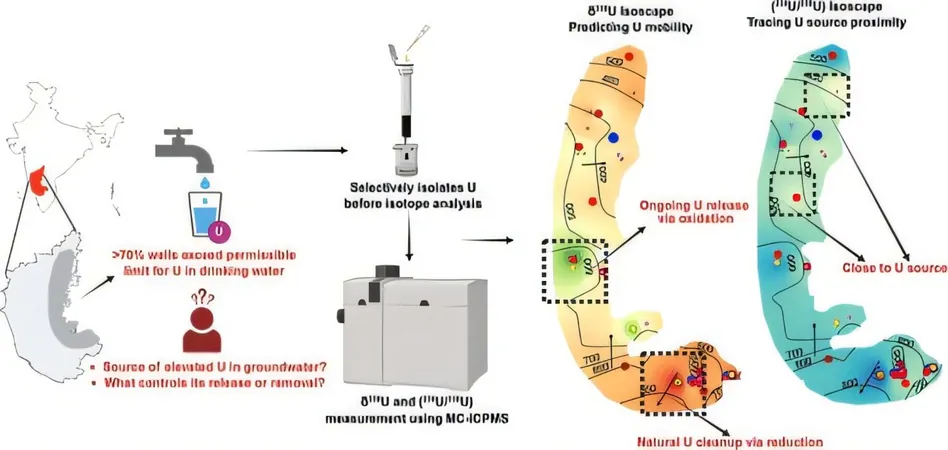
Shocking Discovery: How Uranium is Poisoning Groundwater in India
2025-06-26
Author: Jia
Unveiling the Hidden Dangers of Uranium Contamination
A groundbreaking study out of Columbia University’s Mailman School of Public Health reveals alarming truths about uranium contamination in Eastern Karnataka, India. In this region, a staggering 78% of tested groundwater exceeds safe levels for uranium, with some sources showing contamination levels a shocking 75 times higher than the U.S. EPA’s safety threshold.
Uranium exposure poses serious health risks, affecting vital organs like kidneys, bones, and the liver, yet many instances of contamination remain undetected, endangering the lives of millions.
Mobile Uranium: The Geological Culprit
The team made a significant breakthrough by identifying the geological conditions that enable uranium to become dangerously mobile underground. This discovery could empower local communities, providing them with the knowledge to monitor and manage this environmental crisis effectively.
With over 25 million individuals relying on groundwater for more than 70% of their drinking supply, targeted strategies for well placements and localized treatments at contaminated sites could be life-saving.
Forensic Analysis: Tracing Uranium Back to Its Roots
Collaborating with experts from the Divecha Center for Climate Change and leading Indian institutes, the researchers conducted forensic investigations employing cutting-edge isotopic analysis. This technique measures minute differences in atoms, allowing them to trace uranium’s origin and movement in the aquifers embedded in hard rock.
Their findings pinpoint that the highest contamination occurs in "oxidizing environments,” where uranium leaches into the water. In contrast, “reducing zones” act as natural barriers, trapping uranium and preventing it from infiltrating drinking supplies.
Moving Forward: A New Roadmap for Intervention
"We're not just identifying uranium; we're unraveling its entire journey and behavior in our environment," states lead author Arijeet Mitra, Ph.D. This vital knowledge could steer interventions to protect millions in the region from hazardous exposure.
The research model can also be applied to other areas with similar contamination challenges, including various states in the western and midwestern United States, reinforcing the urgent need for effective monitoring networks to keep track of uranium levels.
Understanding the Mechanisms for Cleaner Water
Senior author Anirban Basu, Ph.D. elaborates, "Uranium's movement within groundwater relies heavily on its oxidizing conditions." When oxygen is plentiful, uranium remains dissolved and moves with the water. In anaerobic environments, uranium converts into a solid form that settles out, thus preventing further pollution.
By analyzing the isotopic ratios, researchers can create a unique fingerprint for uranium, helping pinpoint its sources and pathways through the environment.
The Future of Safe Drinking Water Starts Now
The study titled "Isotopic Insights into Redox Processes Driving Uranium Distribution in Eastern Karnataka Groundwater" is a call to action for enhanced monitoring and intervention strategies that could safeguard the health of communities exposed to this hidden threat.


 Brasil (PT)
Brasil (PT)
 Canada (EN)
Canada (EN)
 Chile (ES)
Chile (ES)
 Česko (CS)
Česko (CS)
 대한민국 (KO)
대한민국 (KO)
 España (ES)
España (ES)
 France (FR)
France (FR)
 Hong Kong (EN)
Hong Kong (EN)
 Italia (IT)
Italia (IT)
 日本 (JA)
日本 (JA)
 Magyarország (HU)
Magyarország (HU)
 Norge (NO)
Norge (NO)
 Polska (PL)
Polska (PL)
 Schweiz (DE)
Schweiz (DE)
 Singapore (EN)
Singapore (EN)
 Sverige (SV)
Sverige (SV)
 Suomi (FI)
Suomi (FI)
 Türkiye (TR)
Türkiye (TR)
 الإمارات العربية المتحدة (AR)
الإمارات العربية المتحدة (AR)